History of Liberty Village
Liberty Village was originally a manufacturing hub. Today, Liberty Village has transformed into a neighbourhood humming with creativity, innovation, growing companies, retail businesses, entrepreneurs, restaurants, and entertainment. It is a place where, although the type of work looks different, is still like the past in the sense that people continue to meet, connect, create and innovate today here today.
Liberty Village has gone through a transformation compared it what it once was, however, you can still find the beauty of the past and essences of its history in what the buildings have become today.
LIBERTY VILLAGE IN THE PAST
Liberty Village a highly industrial area – this was a result of the access to the main downtown lines of the Canadian Pacific and Grand Trunk railways – now known as CN Railways.
What was once the site of Toronto’s Industrial Exhibition – is now what we now know as the Canadian National Exhibition (CNE) – a long-standing tradition for many Torontonians. The Toronto Industrial Exhibition moved south across the rail corridor in 1853. 26 years later, in 1879 it became home to the CNE.
HISTORIC LANDMARKS | THEN & NOW
CENTRAL PRISON
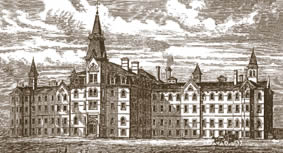
From 1873 to 1915 Liberty Village was home to Central Prison, also known as Toronto Central Prison. Keeping to Liberty Village’s roots in industrialism – the prison acted as an industrial facility where prisoners would work while incarcerated – with the intention of making money for the prison and a form rehabilitation for the prisoners. While most of the grounds are now townhouses – the Central Prison’s Roman Catholic chapel remains intact on East Liberty St. and is listed as a heritage property.
1915 Liberty Street
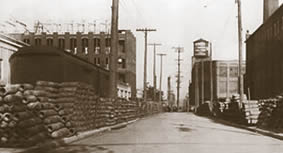
The corner of North corner of Liberty Street and Dufferin Street was a very different place in 1916 – what is now a parking lot was once the site of the Russel Motorcar Company. The company manufactured fuses for bomb shells during World War I. Many of the 4,000 employees were women. Fun fact: The factory operated 24/7!
The Toronto Carpet Factory
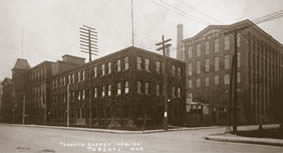
The Toronto Carpet Factory is currently where many Liberty Village based businesses, restaurants, and cafes are located. The building still features many of the original architectural features. The building was originally built between 1899 and 1920 by the Hayes family. This English Industrial style building was where The Barrymore brothers manufactured woven carpets, converting the looms to make coats and blankets for soldiers in World War I and II. The brothers also manufactured furniture at 77 Mowat Avenue.
The ‘Castle’
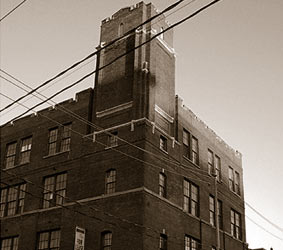
135 Liberty Street was once the production facility for the famous ‘Magic’ Baking Powder brand, which was produced by E.W. Gillett Company. Up until 1912 the corner was also home to Diamond Park, a large covered stadium for the Eastern Baseball League, a professional league at the time. This corner is now an office building for a variety of businesses including companies like Kobo and StickerYou. Liberty Village continues to be home base to professional sports teams, at Lamport Stadium.
Snooker Street
99 Atlantic Avenue and 38 Hanna Avenue, originally built in 1890 of post and beam construction was purchased by The Brunswick Bakle Collender Company – the company manufactured floors for bowling alleys and later ventured into manufacturing billiards tables, cues, and balls after acquiring the Samuel May Company in 1910. When the Academy of Spherical Arts restaurant, took over the building in 1991, the street was renamed Snooker St. to pay homage to the past. The building is now being rebuilt to create additional retail and office space.
The Liberty Market
What is now The Liberty Market (est. 2003) – a mix of restaurants, retail businesses, and services – was once owned by John Inglis and Sons. The company operated a flour mill from 1881 to 1902. In 1902 the company became a machinery business – manufacturing marine steam engines and waterworks pumping engines. In 1904 American, Major J.E Hahn purchased the company and used the site to manufacture the Bren Light Machine Gun – used during World War II. Post war the company manufactured consumer products including fishing tackle, house trailers, oil burner pumps and domestic heaters and stoves. Between 1946 and 1981 John Inglis Co. Ltd. took over and began manufacturing appliances for the company Nineteen Hundred Corporation now known as Whirlpool. The company moved to Mississauga in 1981.
Hanna Avenue
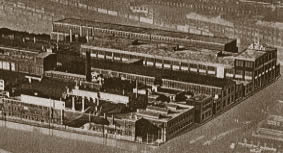
Until 1962 41 Hanna Avenue was the head office of Hinde & Dauch Paper Mill – the company produced cardboard boxes. In 1962 Domtar Corporation, also a paper mill took over the site – the company is now one of the largest integrated producers of uncoated free-sheet paper in North America. Next door, 43 Hanna Avenue, was the head office of Irwin Toys, the Irwins was a manufacturing and marketing company for leisure products including toys and sporting goods. Both buildings have been transformed in condominiums and lofts. Toy Factory Lofts at 43 Hanna developed by Lanterra Developments won the 2005 Greater Toronto Home Builders’ Association award for Condominium project of the year.

